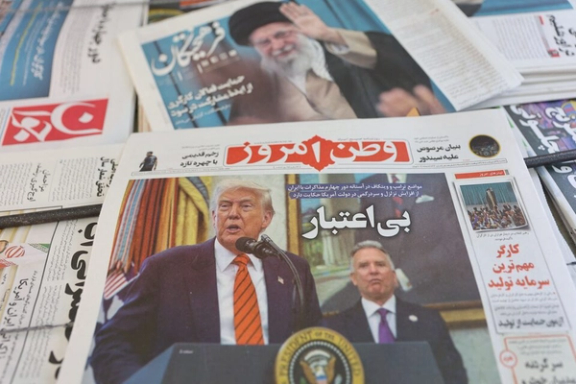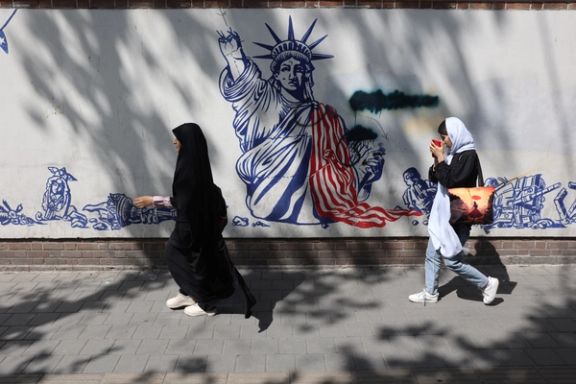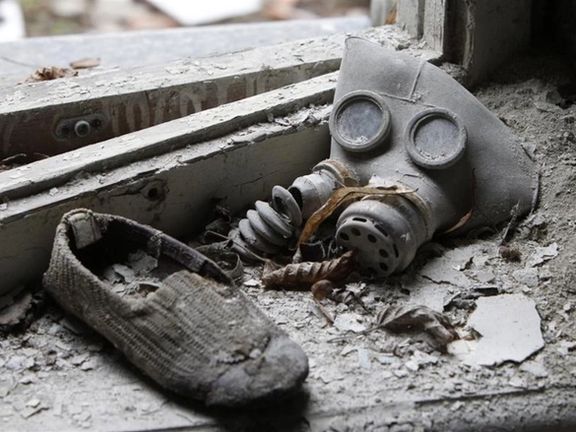Related Articles
Delays in ongoing nuclear negotiations are inflicting damage on Iran’s economy, wrote Iran's Donya-e-Eqtesad newspaper warning that the country's "imbalance-ridden economy is facing a severe liquidity crunch, with depreciation outpacing capital formation, leaving industries parched for investment."
Inflation continues to surge, with rising input costs failing to attract new domestic or foreign capital, the paper noted. Without fresh investment, it added, Iran’s GDP will remain stagnant.
The paper’s “Economists’ Club” section argued that policymakers must pair negotiation planning with domestic reforms, adding that economic security and a stable business environment are key to drawing investment.


Tehran and Washington are set for another round of talks this weekend, but early optimism has dampened amid deep mistrust and mutual threats of attack, making any deal unlikely to lead to a lasting peace.
The most forthright caution, curiously, has come from Iran’s supreme leader Ali Khamenei, who—without referring to the current negotiations—reminded his hardline base that deals with foes are permissible if temporary.
The ultimate foe in Khamenei’s mind, of course, is America: presented more as an evil being than a country - the centerpiece of a narrative that manufactures, and is sustained by, hostility.
This narrative is, in many ways, reciprocated. Successive US administrations have portrayed Iran not just as a rival state, but the world’s leading sponsor of terrorism—a rogue actor bent on disrupting the global order.
Like Tehran’s view of America, this framing is not just rhetoric; it underpins policy, shapes alliances and narrows the space for diplomacy.
As talks resume, staunch anti-Americans in Iran warn against trusting “the Great Satan”, while the so-called hawks in the US decry any compromise with “the Mad Mullahs.”
Ingrained enmity
Despite gestures suggesting de-escalation—like the quiet removal of American flags from Iranian street protests—the hostile rhetoric has not faded. That’s because the tension is embedded not just in language, but in military posture.
The Trump administration has deployed two new warships to the region and deepened defense ties with Israel and Iran’s Arab neighbors.
Meanwhile the Iran-backed Houthis in Yemen managed to strike deep into Israel with a ballistic missile landing near its main airport on Saturday.
Both sides are redrawing lines of confrontation. Diplomacy is conducted under a constant shadow of war.
"I’m issuing a serious warning: if you make one wrong move, we will open up the gates of hell on you," Islamic Revolutionary Guard Corps chief Hossein Salami said on Thursday, referring to the United States and Israel.
"Sit down and stay in your place ... we have made extensive preparations."
The US government is not far off in tone. President Trump has framed the talks as a binary choice: agreement or war. “There are only two alternatives there," he told a conservative podcast on Wednesday. "Blow them up nicely or blow them up viciously."
Israel’s open threats to strike Iranian nuclear facilities and its insistence on the right to preemptive action only heighten the pressure.
In this climate, negotiations serve less to resolve conflict than to manage it. As long as each side sees the other as an irredeemable enemy—and enters talks prepared for battle—diplomacy becomes an extension of confrontation by other means.
Khamenei’s message about temporary deals may have been cryptic. But it had a clear implication: that diplomacy is a tool for crisis management, not conflict resolution.
Tehran and Washington may speak of de-escalation, but their dominant narratives remain unchanged—and the structures that sustain enmity show no signs of retreat.
Seen in this light, the ongoing talks appear to be more of a phase in a familiar cycle than an auspicious breakthrough.
Even if a deal is reached, without structural change, the hostility will likely endure—and should it unravel, military confrontation may appear a legitimate course more then ever.
The negotiations between the United States and the Islamic Republic are in a fragile state and require reassessment by Tehran and courage in decision-making, Iranian political analyst Alireza Namvar Haghighi told Iran International.
He said if Iran does not reach an agreement with the US, it will face a range of economic, diplomatic, and cyber pressures that the ruling establishment will not be able to withstand.

The devastating port blast on Iran’s southern coast has prompted comparisons to the Chernobyl disaster, with some Iranian thinkers seeing echoes of the Soviet Union’s final days in their own country’s unraveling.
Like the explosion at the nuclear power plant in 1986, the deadly blast at Iran’s Bandar Abbas port—reportedly caused by missile fuel stored at a civilian facility—has become a symbol of decay, incompetence, and state secrecy.
Chernobyl ushered in political change and the collapse of Communism. Could this be the beginning of the end of the Islamic Republic?
Historical analogies are never perfect, but they are often revealing.
In the late 18th century, both Russia and Iran were backward agrarian societies ruled by monarchs, burdened by inequality, and haunted by their failures to modernize. Russia's army was a formidable force, but the empire still lagged behind Western Europeans in industry and capital accumulation.
By the mid 19th century, leftist and liberal movements had begun to emerge in Russia, aiming to abolish serfdom and challenge autocracy as part of a broader push for modernization. In Iran too, the educated few, often inspired by the west, were beginning to call for fundamental change.
In Russia, this quest culminated in the dual revolutions of 1917. In Iran, it led to the Constitutional Revolution of 1905 which brought Iranians partial representation but little material progress.
That began only with the rise of Reza Shah in 1925.
Reza Shah confronted the clergy and their medieval traditions' hold on Iranian society. He oversaw an extensive program of modernisation that continued under his son and transformed the country in many ways.
But without democratic development and under pressure from leftist and clerical opposition, Iran’s own “October Revolution” came in 1979.
As in Russia, Iran's post-revolutionary regime was anti-West. It was largely backed by pro-Soviet activists—most of whom were soon crushed by the religious camp while some quietly adapted and remained in the system.

The Islamic Republic, like the Soviet Union, sidelined foreign capital, prioritized homegrown militarization, and sustained itself on repression and slogans. After almost half a century, the revolutionary fervor is gone, corruption is rampant, and the economy is wrecked with years of sanctions and mismanagement.
Could it be argued then that the Islamic Republic today stands at a similar crossroads to that of the Soviet Union in the late 1980s? I think not.
Yes, the theocracy is under enormous pressure from the United States and Israel. A clear majority reject the ruling ideology and want out, as evidenced by widespread protests and growing defiance of Islamic restrictions.
But the Soviet Union had reform-minded leadership.
By the 1980s, some Soviet leaders recognized the system’s failure."The only one truly believing in Communism at the time was chief ideologist Mikhail Suslov," the last leader of Armenia’s Communist Party, Karen Demirchian, told this author in 1999.
And at the very top stood Mikhail Gorbachev, who became General Secretary in 1985 and launched the reformist movement of Perestroika and Glasnost.
By contrast, Iran is ruled by an 85-year-old cleric, Ali Khamenei, who is no Gorbachev— and may even have a few lessons to teach Suslov in rigidity. Khamenei's security forces have shown no hesitation in shooting unarmed protesters.
Gorbachev could act because the Soviet Union was run by a monolithic party that controlled the state, the military, and the security services. No party apparatus rules in Iran. Power rests with one man who presides over a web of largely dysfunctional institutions, tied and surviving mainly by their will to repress.
The Soviet Union collapsed not by popular uprising, but with Gorbachev's top-down liberalization. No such campaign would be entertained let alone initiated by the leader of the Islamic Republic.
The explosion in Bandar Abbas may have shocked and angered Iranians, but it was no Chernobyl in scale—and it's unlikely to be a Chernobyl in impact. Khamenei has never been fond of reform. Until he’s gone, any 'Soviet moment' is more of a warning than a turning point.

President Masoud Pezeshkian's government has yet to mount a defense to parliamentary motions aiming to impeach two of his ministers following the port blast that killed scores and injured more than a thousand people.
Hardline MPs have initiated a process that may result in Pezeshkian losing his energy minister Abbas Aliabadi and transport minister Farzaneh Sadeq, but the president has yet to enter the fray.
The inaction could be calculated, hoping that the impeachments calm a public angered by the tragic event and the lack of accountability. It could also deflect attention from the state entities involved in the port's operations which would otherwise take most of the heat for the apparent accident.
First to be named in the parliament was Sadeq, one of the very few female ministers in the history of Iran. She was to be held accountable for “oversight and inefficiency,” according to five MPs sponsoring the motion.
Calls to impeach Aliabadi gained traction shortly after. MPs blamed him for power outages that harmed households and industries. Surprisingly, some from the pro-Pezeshkian camp backed the motion.
“When a minister is weak, he must be replaced,” former presidential candidate Mostafa Hashemi Taba was quoted as saying by the moderate daily Arman-e Melli.
Another moderate outlet, Khabar Online, reported that hardliners in Iran's parliament—mainly from the ultraconservative Paydari Party—had been planning to remove both ministers since March, following the ousting of economy minister Abdolnasser Hemmati.
Back then, the administration didn't concede without a fight.
Officials and moderates outlets launched a campaign warning that impeachments would weaken the administration’s legitimacy, some even asserting cryptically that supreme leader Ali Khamenei viewed Pezeshkian's government as the Islamic Republic's last viable option and opposed destabilization.
Hardliners often submit multiple impeachment motions to increase the chances of at least one being approved for parliamentary debate.
Unofficial reports in Iranian media suggest Sadeq may be removed to show the government is responding to public demands.
Those with most power—and more likely to be culpable for the port blast—are expected to remain untouched: the Revolutionary Guards (IRGC), for example, or the Mostazafan Foundation, which operates under Khamenei’s office.
The IRGC likely imports weapons materials through the port, which a subsidiary of the foundation operates.
The motion to impeach Sadeq has over forty signatures to date, according to an official tally, which can be read as a sign of things to come as no more than ten is required to set off the proceedings against a minister.
Previous initiatives to impeach Sadeq fell short, according to unofficial reports in Tehran's media, because Pezeshkian had hinted in closed session that she was Khamenei’s preferred candidate.
This time, the only outlet to come out in support of the transport minister is Etemad, whose proprietor Elias Hazrati serves as the government’s public relations chief. The daily has framed the motion as a move against the government.
Pezeshkian or his team are yet to publicly defend the two embattled ministers. It is a rare silence, perhaps signaling their patience until an actual battle in the parliament if and when the impeachment takes place.
